

Music of Egypt. Music has been an integral part of Egyptian culture since antiquity.
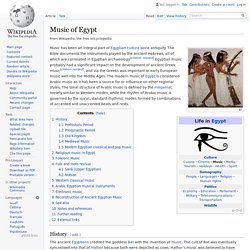
The Bible documents the instruments played by the ancient Hebrews, all of which are correlated in Egyptian archaeology. [citation needed] Egyptian music probably had a significant impact on the development of ancient Greek music[citation needed], and via the Greeks was important to early European music well into the Middle Ages. The modern music of Egypt is considered Arabic music as it has been a source for or influence on other regional styles. Egyptian Music.
Musicians of Amun, Tomb of Nakht, 18th Dynasty, Western Thebes.
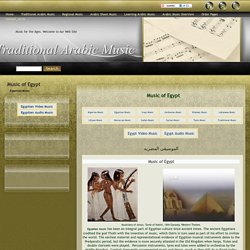
Egyptian music has been an integral part of Egyptian culture since ancient times. The ancient Egyptians credited the god Thoth with the invention of music, which Osiris in turn used as part of his effort to civilize the world. The earliest material and representational evidence of Egyptian musical instruments dates to the Predyanstic period, but the evidence is more securely attested in the Old Kingdom when harps, flutes and double clarinets were played. Percussion instruments, lyres and lutes were added to orchestras by the Middle Kingdom. Cymbals frequently accompanied music and dance, much as they still do in Egypt today. Egyptian traditional folk music: Mohamed el Sayed 1. Egypt Nubian Music. Klezmer. Style of Jewish music Klezmer (Yiddish: כליזמר or קלעזמער (klezmer), pl.: כליזמרים (klezmorim) – instruments of music) is a musical tradition of the Ashkenazi Jews of Eastern Europe.
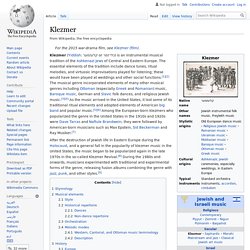
Played by professional musicians called klezmorim in ensembles known as kapelye, the genre originally consisted largely of dance tunes and instrumental display pieces for weddings and other celebrations. In the United States the genre evolved considerably as Yiddish-speaking Jewish immigrants from Eastern Europe, who arrived between 1880 and 1924,[1] came into contact with American jazz. During the initial years after the klezmer revival of the 1970s, the American sub-variety was what most people knew as klezmer, although in the 21st century musicians began paying more attention to the original pre-jazz traditions as revivalists including Josh Horowitz, Yale Strom and Bob Cohen have spent years doing field research in Eastern/Central Europe.
Etymology[edit] Style[edit] History[edit] Repertoire[edit] Time[edit] KLEZMER MUSIC. Klezmer music originated in the 'shtetl' (villages) and the ghettos of Eastern Europe, where itinerant Jewish troubadours, known as 'klezmorim', performed at joyful events ('simkhes'), particularly weddings, since the early middle age till the Nazi and Stalinian prosecutions.
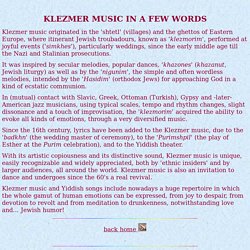
It was inspired by secular melodies, popular dances, 'khazones' (khazanut, Jewish liturgy) as well as by the 'nigunim', the simple and often wordless melodies, intended by the 'Hasidim' (orthodox Jews) for approaching God in a kind of ecstatic communion. In (mutual) contact with Slavic, Greek, Ottoman (Turkish), Gypsy and -later- American jazz musicians, using typical scales, tempo and rhythm changes, slight dissonance and a touch of improvisation, the 'klezmorim' acquired the ability to evoke all kinds of emotions, through a very diversified music. back home "Klezmer: it's not just music - it's a way of life!
" (Hankus Netsky) Jewish Klezmer Music. Indonesian folk music. Music Of Indonesia: Traditional Musical Instruments of Batak Toba, North Sumatra. Hi, welcome back traditional Indonesian music lovers, If yesterday we've discussed Rapai which is mostly a traditional musical instrument of Aceh, today we will discuss the traditional music of North Sumatra province, tapatnya Batak Karo.

Indonesian nation known for its diversity and ethnic tribe, until now there are about 1300 an ethnic group in Indonesia, each ethnic tribe is certainly has no traditions and cultural particularities of each. The diversity of art and culture that exist in the world, and in Indonesia in particular gives much influence to human civilization, as well as the art of music, traditional musical instruments carry a very significant influence on the development of music. Music is organized sound so that it contains a rhythm, song, and harmony, especially the sound produced from the tools that can produce sounds. (Wikipedia) Special about the solo instrument, the approach taken is also a more specific nature. 1. Oloan Panggora Hesek Garantung 2. Taganing Odap 3. Sulim 4. Traditional Japanese music. Traditional Japanese music or 邦楽 (hōgaku), meaning literally (home) country music (as opposed to 洋楽 (yōgaku) - Western music) is the folk or traditional music of Japan.
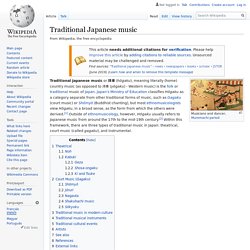
Japan's Ministry of Education classifies Hōgaku as a category separate from other traditional forms of music, such as Gagaku (court music) or Shōmyō (Buddhist chanting), but most ethnomusicologists view Hōgaku, in a broad sense, as the form from which the others were derived.[1] Outside of ethnomusicology, however, Hōgaku usually refers to Japanese music from around the 17th to the mid-19th century.[2] Within this framework, there are three types of traditional music in Japan: theatrical, court music (called gagaku), and instrumental. Theatrical[edit] Japan has several theatrical forms of drama in which music plays a significant role. The main forms are kabuki and noh. Noh[edit] Noh (能) or nōgaku (能楽) music is a type of theatrical music. Kabuki[edit] Geza[edit] Shosa-ongaku[edit] Traditional Japanese musical instruments. Traditional Japanese musical instruments are musical instruments used in the traditional and folk music of Japan.
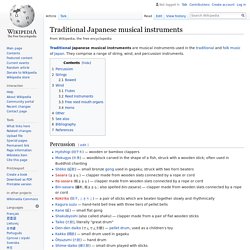
They comprise a range of string, wind, and percussion instruments. Percussion[edit] Strings[edit] Bowed[edit] Kokyū - bowed lute with three (or, more rarely, four) strings and a skin-covered body. "Koto" Traditional Japanese musical instrument. Japanese traditional musical Instrument in Talented Hands Bon Voyage - Aun & Hide. Traditional Irish Folk Music. Celtic Music Instruments - Irish Folk Instruments. African Music, Dance, Music and Musical Instruments. Indigenous African musical and dance expressions that are maintained by oral tradition and that are stylistically distinct from the music and dance of both the Arabic cultures of North Africa and the Western settler populations of southern Africa.

African music and dance, therefore, are cultivated largely by societies in sub-Saharan AfricaAll sub-Saharan traditions emphasize singing, because song is used as an avenue of communication. Because many African languages are "tone languages," in which pitch level determines meaning, the melodies and rhythms of songs generally follow the intonation contour and rhythms of the song texts. Melodies are usually organized within a scale of four, five, six, or seven tones. In group singing, some societies habitually sing in unison or in parallel octaves with sporadic fourths or fifths; others sing in two or three parts, using parallel thirds or fourths.
African Traditional Music. Music of Africa. Given the vastness of the continent, the traditional music of Africa is historically ancient, rich, and diverse, with the different regions and nations of Africa having distinct musical traditions.
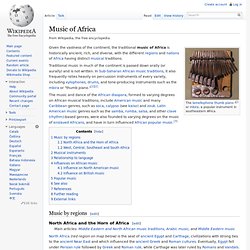
Traditional music in much of the continent is passed down orally (or aurally) and is not written. In Sub-Saharan African music traditions, it also frequently relies heavily on percussion instruments of every variety, including xylophones, drums, and tone-producing instruments such as the mbira or "thumb piano. "[1][2]